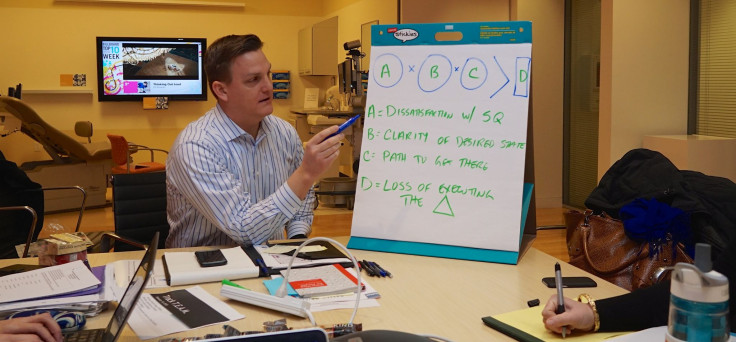Can ‘Shark Tank’ Solve The US Government's Most Vexing Problems?

Eleven teams presented their best ideas to seasoned investors on Thursday morning at a rapid-fire pitch session in Washington, D.C. Over the past three months, the teams poured through volumes of customer research, sweated over prototypes and figured out how to sell their concept in just four minutes. Then, the investors peppered them with questions about shareholder engagement and return on investment before lending advice about how to refine the ideas and deciding whether to back the projects.
This isn't a scene from an upcoming episode of ‘Shark Tank’ – it's actually a U.S. Department of Health and Human Services exercise to elicit innovative ideas for reducing costs, improving services and solving some of the agency's "most vexing problems." The competitors were federal employees and the ‘Sharks’ were senior HHS leaders with the funding and manpower to introduce contestants' most clever solutions to public health.
The teams presented ideas ranging from developing a smartphone app to track outbreaks of foodborne bacteria to helping nursing homes tap $150 million in unused funds. One team proposed a task management tool to help National Institutes of Health employees sort through the 32,000+ applications they receive each year for grants and other purposes.
“There are clearly opportunities for innovation at many levels of government but at the same time, there's so many current needs that it's often hard to step away and really think about how to change the way we're doing things,” Michael Johansson, a 37-year-old participant in a past pitch day and a biologist at the Centers for Disease Control and Prevention, says.
The event is part of a larger push by President Obama to bring innovation to the government and make public service “cool again” to young people. So far, his track record is not great. The Partnership for Public Service assigns an annual innovation score to the government and that score dropped to 58.9 points out of 100 last year. It has steadily declined since the group began tracking it in 2010.
At the same time, the government has struggled to recruit young people. The average federal employee has worked in the government for 14 years. In 2013, the percentage of federal employees under 30 years old fell to 7 percent – the lowest figure in almost a decade.
When the Department of Health and Human Services launched an “Idea Lab” in 2013, the aim was to empower public employees to work with each other and outside collaborators to cut through red tape or dream up novel solutions for pressing public issues.
President Obama’s 2016 budget sets aside money for the creation of more Idea Labs at the Departments of Education, the U.S. Treasury, the General Services Administration and the Small Business Administration. The Commerce Department has requested $3 million to start one and the Department of Health and Human Services wants $3 million to expand its own.
The HHS pitch session is the grand finale to a three-month Idea Lab program called the Ignite Accelerator. Teams complete a three-day “boot camp” in which leaders from the University of Maryland and federal agencies school them in start-up tactics such as developing a prototype, surveying customers and crafting a pitch deck.
Thursday’s pitches mark the fourth group of employees to complete the accelerator, and several ideas from past sessions have taken hold.
For example, applicants to the National Health Service Corps and Nurse Corps used to spend about six days completing an application for the programs. The system required them to manually enter all their student loans (applicants had five on average) and upload two supporting documents for each one. Then, analysts would carefully review 12,000 applications between the two programs to verify that each loan was real – a process that took another six days per application.
Jamie Elliott, 30-year-old branch chief at the Bureau of Healthcare Workforce, realized that 90 percent of applicant’s loans were federal loans, so he reached out to the Department of Education and built software that would automatically fill those loans in for each applicant, and save analysts the bother of verifying them. Analysts now spend about three days on each application instead of six.
Overall, 48 teams have completed Ignite. They’ve invented an online exchange for 3-D printing designs and motion comics to teach kids about HIV. Not all of their ideas have worked out.
“Broadly, about a third of the teams have received their requested time and money,” Read Holman, the 31-year-old program director for Ignite, says. “About a third of the teams, their project has sort of died on the vine and not gone anywhere and about a third of the teams are somewhere in the middle. And we think that's pretty good.”
Holman says the program is in the process of evaluating its own returns and summarizing the cost or labor savings generated by all Ignite projects to date. Molly Alawode, a public health consultant with IQ Solutions, watched the last Ignite pitch session in the spring. She says innovation within the government doesn’t always look as flashy as it does in Silicon Valley, but that doesn’t make it any less important. She adds that it was refreshing as a consultant to see innovate thinking within the department.
Her favorite project was Johansson’s – an online portal to help disease modelers describe outbreaks in a way that will help policy leaders and hospital administrators to better respond to them by providing details such as when an outbreak is likely to hit its worst point.
" I was like yes -- this is exactly what public health needs right now,” she says.
© Copyright IBTimes 2024. All rights reserved.






















